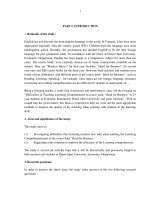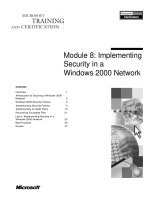MODULE 8 TEACHING LISTENING
Bạn đang xem bản rút gọn của tài liệu. Xem và tải ngay bản đầy đủ của tài liệu tại đây (46.6 KB, 6 trang )
MODULE 8: TEACHING LISTENING
1. What is listening?
Listening is a language skill which involves a wide range
of'sub-skills'. It is more than simply hearing; it is 'decoding'
sounds and understanding the meaning behind those sounds
Some of the sub-skills involved in listening are:
1. Recognizing differences between phonological sounds. For
examples, we must be able to notice a difference between/g/ and
/k/ in the word 'pig' and 'pick'.
2. Comprehension of structures (parts of speech, sentence
patterns )
e.g.: In the sentence, Would you please pick the phone up? the
listener must notice that 'pick' is the verb and ’phone' is a noun.
Besides, the listener must recognize from the word order and
intonation pattern that the sentence is a question.
1
1
3. Guessing at unknown words or recognizing words that arc
unnecessary . for understanding. Guessing is done by noticing the
context or looking at the grammar of the sentence.
e.g.: In the sentence, "The police hit I he man with a billy club the
listener can guess at the meaning of the word 'billy' or ignore it.
4. Recognizing discourse markers and cohesive words which help
hold the discourse together. These discourse words include nouns
which are later referred to by pronouns, articles, determiners,
connectors like first, second, next, finally, therefore,
e.g.: Last week my sister Jane sent me a letter. She had good
news
A spaceship landed on our apartment building last night.
The ship was huge with bright lights all over it This flying
object was
5. Ability to infer information that is not directly stated,
e.g.: Woman: I want to complain about a man abusing me.
2
2
Policeman : Did the man hit you?
Woman : lie was screaming at me and threatening me.
6. Skimming
The skill of understanding the main idea
7. Summarizing:
The listener will try to repeat or reduce the main points into
fewer words
8. Scanning
The skill of looking for specific information
9. Critical listening
The skill of understanding
10. Recognizing different styles, emotional tones and varieties of
language
The skill of understanding
10. Recognizing different styles, emotional tones and varieties of
language
- Styles: Formal / Informal
3
3
- Tones: Angry / Excited / Quiet
- Varieties: American / Brish / Indian – English
11. Predicting what a speaker will say next
In order to listen to more carefully
12. Listening for total comprehension
The listener has to understand everything the speakers says
2. The Importance of Listening:
We cannot develop speaking skills unless we also develop
listening skills; the ability to understand spoken English
may become very important (for listening to the radio,
understanding foreign visitors, studying…
Listening to spoken English is an important way of
acquiring the language of I 'picking up' structures and
vocabulary. We need to give students as much opportunity
to listen to spoken English as possible because they do not
have the language environment outside the classroom.
4
4
3. Learners problems
- Trouble with sounds
- Having to understand every word
- Can’t understand fast, natural native speech
- Need to hear things more than once
- Find it difficult to keep up
- Get tired
4. Types of listening activities
- No overt response
- Short responses
- Longer responses
- Extended responses
5. Principles for teaching listening
1. Use authentic texts and present them as naturally and
realistically as possible.
2. Include various types of texts
5
5
3. Use primarily meaning – based tasks
4. State a specific purpose for listening task
5. Introduce a listening task
6. Generally, it is best to avoid pre – teaching vocabulary unless
necessary
7. Let students listen to the text more than once
6
6









